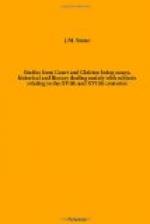On the Bewcastle Cross there is less of the national element and more of the Roman, fewer runes and more of this kind of sculpture. A few feet from the parish church, and within the precincts of a large Roman station, guarded by a double vallum, stands the shaft of what was formerly an Anglo-Saxon funeral cross of most graceful shape and design. This column, 14 feet in height, is quadrangular, and formed of one entire block of grey freestone, inserted in a broader base of blue stone. The side facing westward has suffered most from storm and rain. It bears on its surface two sculptured figures, and the principal runic inscription. The lower figure, that representing our Lord, has been much mutilated by accident or design. He stands as He is seen on the Ruthwell Cross, with His feet on the heads of swine, as trampling down all unclean things. His right hand is uplifted in blessing, in His left hand is a scroll,
Above is St. John the Baptist holding the Agnus Dei, and near the top are the remains of the Latin word Christus.
The runic inscription has been translated thus:
“This slender sign-beacon
set was by Hwoetred,
Wothgar, Olufwolth,
after Alcfrith
Once King
eke son of Oswin
Bid (pray) for the high sin of his soul.”
Beneath these runes is the figure of a man in a long robe with a hood over his head, and a bird, probably a falcon, on his left wrist. This figure is supposed to represent Alcfrid himself. Immediately below the falcon is an upright piece of wood with a transverse bar at the top, possibly meant for the bird’s perch. On the east side there are no runes, but a vine is sculptured in low relief within a border. Dr. Haigh observed that the design on this side was the same as on the two sides of the Ruthwell Cross.* The north and the south sides are in a state of good preservation, and are covered with a beautiful design in knotwork, and alternate lines of foliage, flowers, and fruit. On the north side there is a long panel fitted with chequers, which have given rise to a good deal of controversy among antiquaries. Camden thought them to be the arms of the De Vaux family, and when this theory was exploded, Mr. Howard of Corby Castle reversed it, and suggested that the chequers on the De Vaux arms were taken from this monument. But the Rev. John Maughan, B.A., rector of Bewcastle, in a note to his tract on this place, cites instances of chequers or diaper-work in Scythian, Egyptian, Gallic, and Roman art, and proves from the Book of Kings that there were “nets of chequered work” in the Temple of Solomon. After remarking that this is a natural form of ornamentation he calls attention to the frequent use made of it in mediaeval illuminations.**
* Archaologia Aeliana, p. 169.
** Archaeological Journal, vol. xi.
Above this panel are the words “Myrcna Kung,” and over the next piece of knot-work is seen the name “Wulfhere” (King of the Mercians). Then follows another vine, and above all are three crosses and the holy name “Jesus.” On the south side runs a runic inscription thus:




